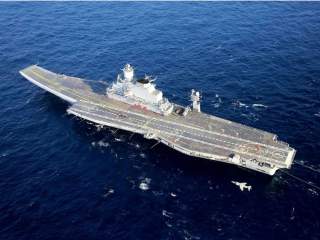Get Ready, India: China's Navy Is Pushing West
New Delhi needs to be clear-eyed about Beijing's ambitions.
That’s a lot of ifs, though. Diverting most of the navy would leave the China seas largely unguarded by heavy forces—an unappealing prospect for Beijing. China will keep its strategic priorities straight unless something truly dire happens in the Indian Ocean, reconciling the leadership to hazards at which it would usually blanch. Those priorities lie mainly off the East Asian coast—mandating that the fleet remain close to home to defend them.
In short, strategy—not capability per se—will dissuade China’s leadership from mounting a major naval presence in South Asia. Look to the strategic canon to see why. Sea-power sage Alfred Thayer Mahan explains how to size fleets for battle. Says Mahan, naval officialdom must apportion a fleet enough ships and armaments to “fight, with reasonable chances of success, the largest force likely to be brought against it.” Shortchanging a formation on numbers or capability, or ignoring what a foe is apt to do with its navy, courts defeat and disaster.
All well and good. Estimating relative combat power is far from simple, but it is doable: tabulate the quality and quantity of platforms deployed by each contender, estimate how a foe’s tactics and skill measure up to yours, add a little surplus, and you have a contingent that can enter the lists with reasonable prospects of success. But what about Mahan’s element of probability? How big a fraction of its strength is that opponent likely to commit to potential scenes of action?
Do some red-teaming to find out. Get to know the adversary and the logic impelling its decision calculus. For that, there’s no better than to start with another of the greats, a man who scarcely acknowledged that oceans and seas exist—namely, Prussia’s Carl von Clausewitz. Clausewitz was forever urging statesmen and generals to stay on target. Once military leaders define an enemy’s “center of gravity,” they should rain “blow after blow” against that “hub of all power and movement” until the foe either calls “uncle” or can no longer put up a fight.
Clausewitz’s monomania primed him to set a high standard for diverting manpower and material into secondary theaters or operations. A combatant, he writes, should refrain from lesser pursuits unless deemed “exceptionally rewarding.” But even if the likely rewards appear exceptional, generals should abjure secondary endeavors unless undertaking them won’t imperil the main theater. For Clausewitz, then, only “decisive superiority” of forces in the main theater warrants detaching resources for peripheral efforts. Stay on target!
And China? It’s far from clear that the PLA Navy commands decisive superiority in the China seas, even when backed up by shore-based fire support—as it is when cruising within reach of airfields and missile batteries arrayed along the mainland’s coastlines. Nor does China stand to gain anything exceptional in the Indian Ocean at present. Yes, Beijing cares deeply about the safety of merchantmen crisscrossing the Indian Ocean. But the PLA Navy can help ward off nonstate scourges like pirates without running undue risk in East Asia—as it has since joining the antipiracy expedition seven years ago. Modest rewards, for modest expenditure of naval resources.
Here’s the crux of our dispute in Jaipur: the Indian dignitaries seem to think China can’t mount a naval threat to India in the Indian Ocean, whereas I think it could but has little incentive to do so. Change the incentives, though, and the situation could change abruptly—to India’s detriment. Never discount the possibility of a “Black Swan.” And bear in mind that Clausewitzian logic will prove less and less forbidding for Beijing over time. As the PLA Navy matures and swells in numbers, China may come to command decisive superiority in the most crucial theater (the Western Pacific) with forces to spare for Indian Ocean adventures. The ghosts of Clausewitz and Mahan will smile.
So the quad-plus dialogue exposed a significant difference in perspectives—one worth belaboring. Let’s not assume away the potential of Chinese sea power, and let’s not assume away Chinese political resolve, the instigator for martial enterprises. Last week one leading Chinese commentator, Fudan University’s Shen Dingli, prophesied that Beijing could summon the resolve to dispatch aircraft-carrier task forces to the Indian Ocean to “hurt” India. If India joins a seafaring league alongside America and its allies, says Shen, “of course we can put a navy at your doorstep.”
PLA Navy flattops at Gwadar: that prospect should give Indians pause.
James Holmes is Professor of Strategy at the Naval War College and coauthor of Red Star over the Pacific and Indian Naval Strategy in the 21st Century. The views voiced here are his alone.
Image: Wikimedia Commons/Indian Navy

